Come explore Colorado Music Hall of Fame’s music history archives.
Each month, we feature a different item From Our Collection.
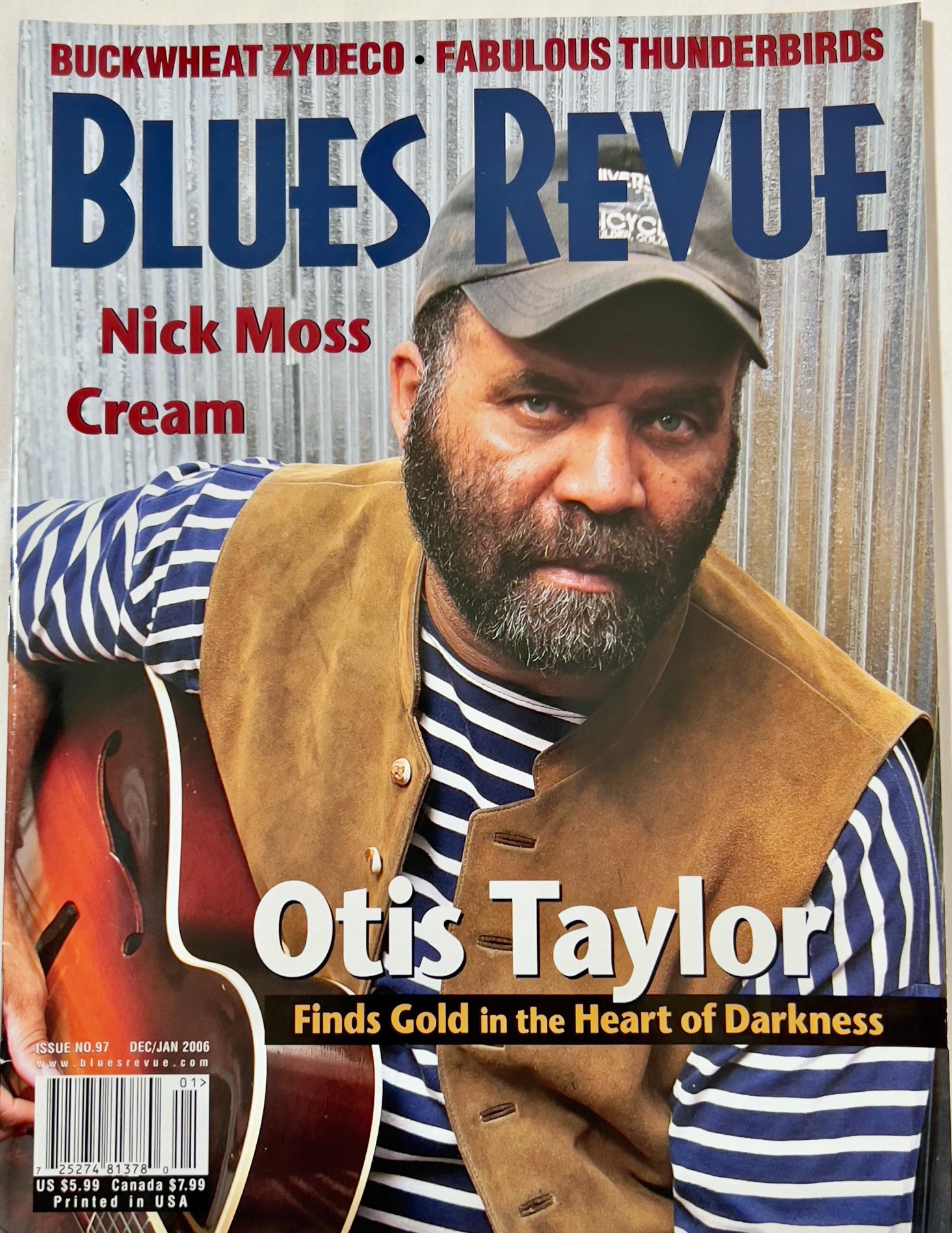
Born in 1948 in Chicago, Otis Taylor moved with his family to Denver at a young age. According to Taylor, his parents were both jazz fans. But young Otis began hanging around the Denver Folklore Center, getting exposed to the music of Mississippi John Hurt and country blues. The first instrument Taylor learned to play was the banjo, but he soon rejected the instrument due to its association with the racist American South. He then focused solely on the guitar and harmonica but would eventually return to the banjo upon discovering its African roots.
Taylor has played music professionally both in Europe and the United States in a variety of blues-oriented bands, including Hall of Famer Zephyr, until 1977 when he left the music industry for other pursuits. He returned to music in 1995, working with another inductee, Kenny Passarelli, who produced his first album “Blue Eyed Monster.”
To date, Taylor has released 16 blues albums and received 12 Blues Music Awards nominations. His music tends to focus on the hard realities of life, especially relating to the Black community. Some common themes in his music are murder, racism, poverty and the need for redemption. Personal highlights of Taylor’s career were when he was an answer in the New York Times crossword puzzle in 2009 and in 2016 he was proud to be included in the inaugural exhibition of the Smithsonian’s National Museum of African American History and Culture.
In our collection, The Hall has a 2006 copy of “Blues Revue” magazine featuring Otis Taylor on the cove
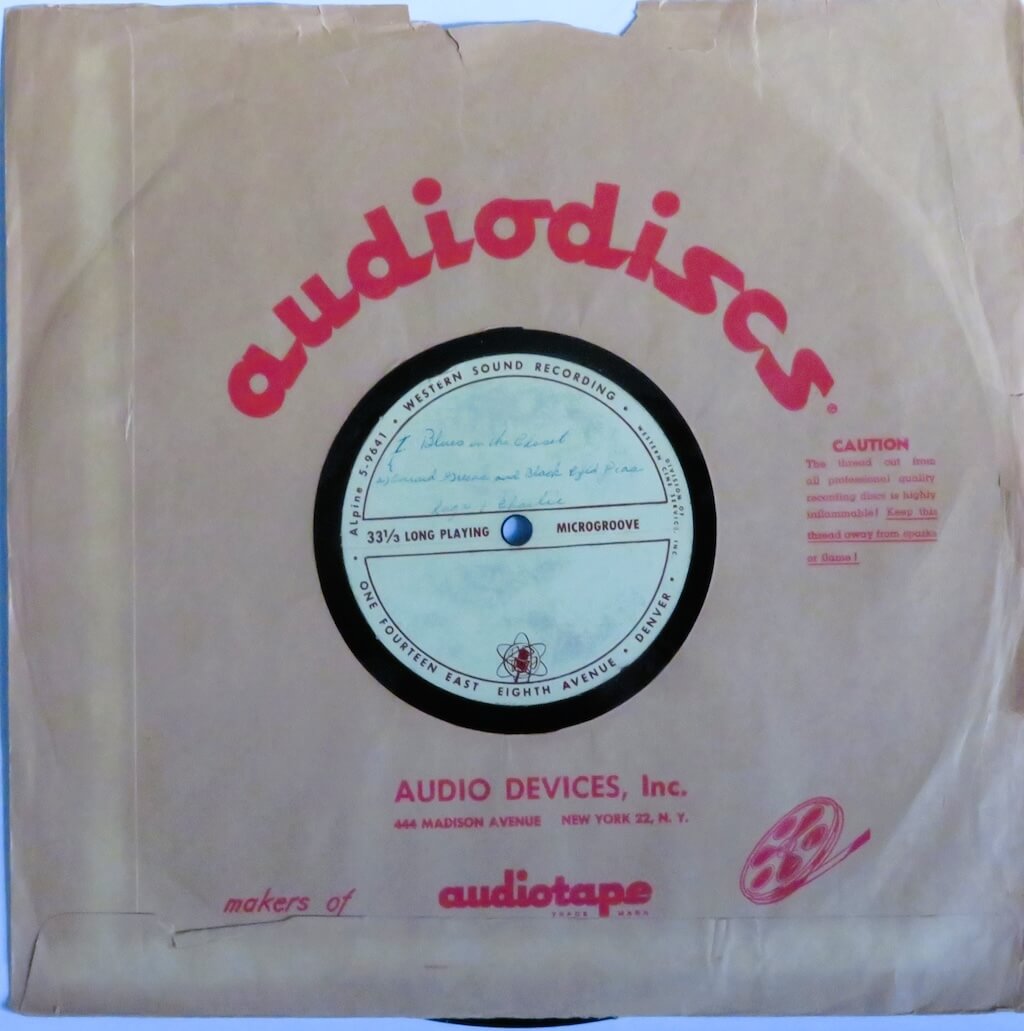
Charles “Charlie” Burrell is a classical and jazz bass player most prominently known for being the first Black to be a member of a major American symphony (the Denver Symphony Orchestra). For this accomplishment, he is often referred to as “the Jackie Robinson of Classical Music”.
Born in Toledo, Ohio in 1920, Charlie joined his mother’s relatives in Denver in 1949. In 1953, he quit playing in the Denver Symphony to become the bass player in Nellie Lutcher’s band. He went on to become a prominent jazz player in Denver’s Five Points area. At that time, the jazz scene in Five Points was the only one between St. Louis and the West Coast, and often called “The Harlem of the West.”
Charlie played in the first integrated jazz trio in Colorado, the Al Rose Trio. He rose to be a central player in the Five Points jazz scene by becoming the house bass player at the Rossonian Hotel, considered the “entertainment central” spot in Five Points during that era. He shared the stage with jazz legends such as Billie Holiday, Charlie Parker, Earl Hines, Duke Ellington, Count Basie and Lionel Hampton.
On his 90th birthday, Charlie was honored on the floor of the U.S. House of Representatives, referring to him as a “titan of the classical and jazz bass.”
Colorado Music Hall of Fame has several Charlie Burrell artifacts in our collection, including an audio disc recording of Burrell and Leon “Rags” Ragsdale. On the disc are “Blues in the Closet” and “Collard Greens and Black-Eyed Peas.” The audio disc was recorded at Western Sound Recording on 8th Avenue in Denver and has a handwritten label.

A native of Fall River, Massachusetts, Moriarty graduated in 1952 from the New England Conservatory of Music (NEC), with which he would be closely associated throughout his stellar career. The NEC created two opera scholarships in his name and awarded him an honorary doctorate to commemorate his many accomplishments working with iconic groups like Santa Fe Opera, Boston Pops and the Colorado Symphony.
Although Moriarty’s primary instrument was piano, he built a reputation for helping vocalists tackle opera masterworks as they were originally written. He was a member of the NEC’s vocal faculty until his retirement in 2015, two years before he received a lifetime achievement award from the National Opera Association, and his 1975 book Diction remains a key text for performers who want to convey authority and passion in a tongue other than their own.
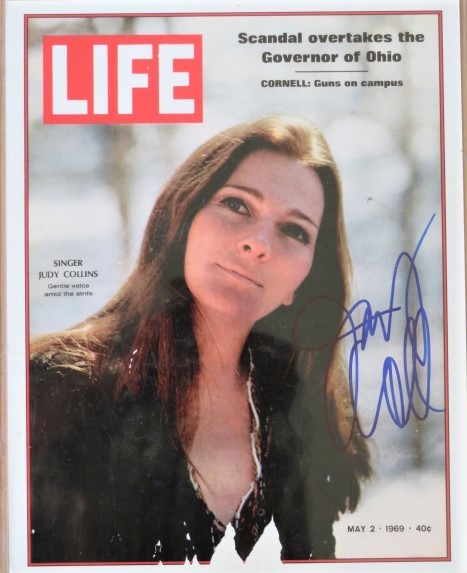
Judy Collins is an American singer and songwriter with a career spanning seven decades. Her discography consists of 36 studio albums, nine live albums, numerous compilation albums, four holiday albums, and 21 singles.
Collins was born the eldest of five siblings in Seattle, where she spent the first 10 years of her life. Her family moved to Denver in 1949, and Judy contracted polio a year later, spending two months in hospital isolation. Yet that didn’t stop her; a child prodigy on the piano, she made her public debut at the age of 13.
Her interest in folk music and guitar brought her to Greenwich Village in New York City, where she played in clubs until she was signed by Elektra Records. In 1961 at age 22, she released her debut studio album, “A Maid of Constant Sorrow.” In 1962, shortly after her debut at Carnegie Hall, Collins was diagnosed with tuberculosis and spent six months recuperating in a sanatorium.
Like many other folk singers of her generation, Collins was drawn to social activism. Collins sympathized with the Yippie Movement and was friendly with its leaders, Abbie Hoffman and Jerry Rubin. In 1971, Collins signed her name to a Ms. Campaign which called for an end to “archaic laws” regarding abortion rights. In the late 1990s, she was a representative for UNICEF and campaigned on behalf of the abolition of landmines. Later songs include “River of Gold” about the environment and “My Name is Maria” about dreamers.
This Life magazine dated May 2, 1969, autographed by Judy to The Hall, contains an extensive interview with Judy sharing childhood insecurities, songwriting, the tumultuous events of the 1960s, and the loneliness of being on the road.
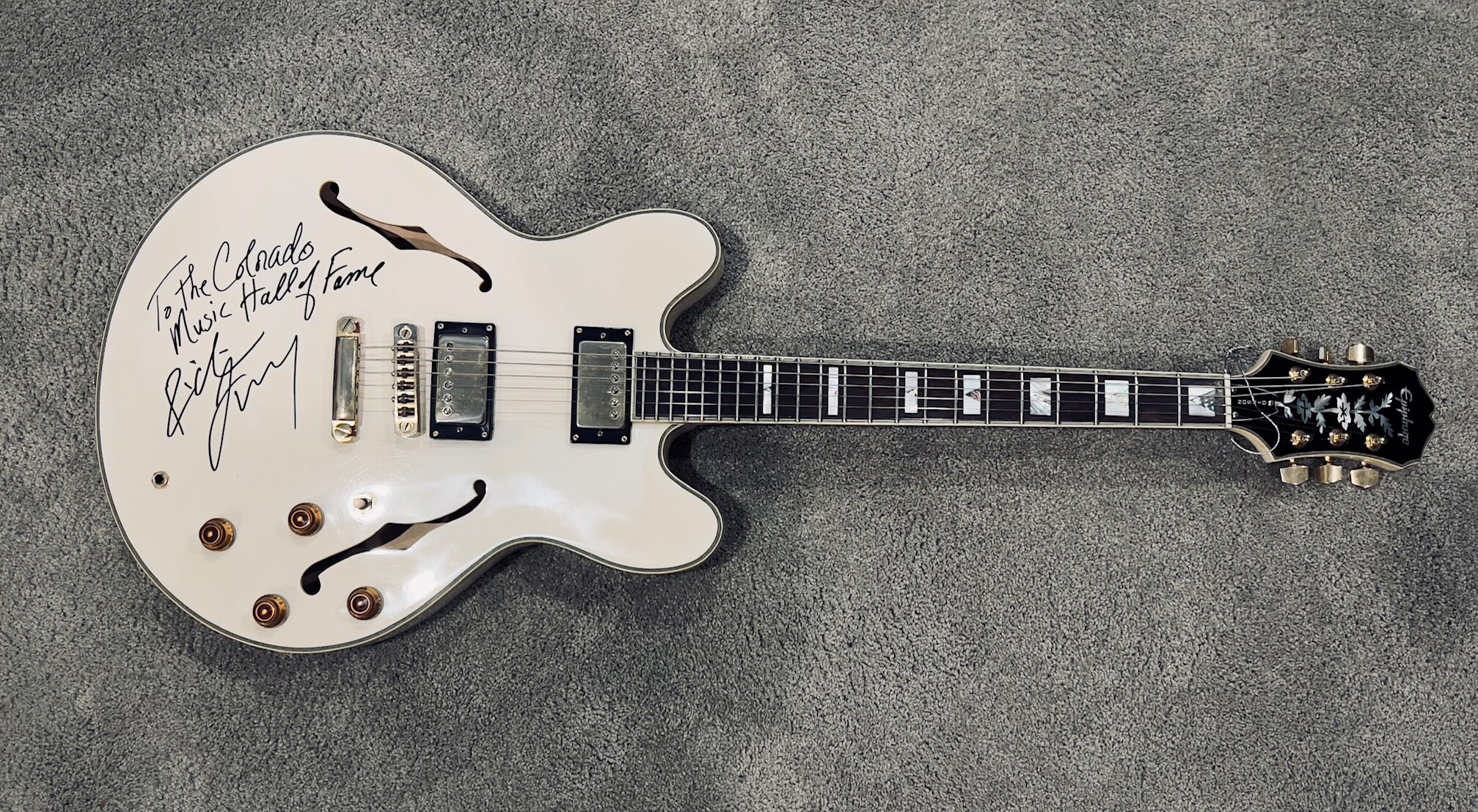
The Boenzee Cryque was a popular Denver-based band formed in 1964. The band included steel guitarist Rusty Young, rumored to be the first steel player to ever record in a rock format. Cryque soon became one of Colorado’s premier acts, recording a couple of singles which were popular locally. During this time, Young was beginning to attract attention from California bands interested in creating a country rock sound. In 1968 Young went to Los Angeles to play steel guitar on Richie Furay’s recording of “Kind Woman.”
With Buffalo Springfield in turmoil, two members, Richie Furay and Jim Messina, quickly moved to create a band of their own. They recruited Young, who called in two buddies from Colorado—George Grantham, also from Boenzee Cryque, and Los Angeles musician Randy Meisner to play drums and bass. Originally named Pogo, the new band had to change their name to Poco due to copyright issues.
Over the next 50 years, Poco had many members come and go, a total of 24 in all. During that time the band released 19 studio albums, 11 live albums, and three top-20 singles. At the end of 2013, the last of the original members Rusty Young announced his retirement from the band. At the age of 68, he said he had spent 45 years on the road in the same band and needed a break. After 55 years in existence, Poco still continues touring to this day.
Colorado Music Hall of Fame has several Poco artifacts in our collection including an all-white Epiphone guitar donated by Richie Furay. The guitar is autographed “To The Colorado Music Hall of Fame, Richie Furay.”

Caribou Ranch was a recording studio built in 1972 by Colorado Music Hall of Fame inductee, producer James William Guercio. A converted barn housed the control room and studio on ranch property near Nederland, Colorado. The studio continued in operation until the barn was damaged by fire in March 1985.
Recording artists came to Caribou Ranch not only for seclusion and scenery but also for the unique sound produced there. During its years of operation, the Ranch hosted over 150 recording artists, including some of the most prominent acts of the 1970s and 80s. Caribou Ranch was most closely associated with the band Chicago, who recorded five consecutive albums there between 1973 and 1977. Elton John recorded three albums at Caribou, one with John Lennon.
After the extensive damage to the studio’s control room caused by the fire in 1985, Caribou Ranch closed for good. During its brief history, Caribou Ranch produced 18 Grammys, 45 Top 10 albums, 20 No. 1 Billboard hits, and more than 100 million record sales.
The Hall has many Caribou Ranch artifacts in our collection including an 8-track tape of Elton John’s tenth studio album “Rock of the Westies,” recorded in 1975 at Caribou Ranch. The album entered the Billboard 200 chart at No.1 and was John’s final chart-topping studio album in the U.S.

Billy Murray was one of the most popular singers in the United States in the early 20th century. While he received star billing in Vaudeville, he was best known for his prolific work in the recording studio. It is estimated he made between 6,000 to 10,000 recordings in 45 years under a range of different pseudonyms, selling over 300 million records, which was a record at the time.
William Thomas Murray was born in Philadelphia in 1877. His parents moved to Denver, Colorado, in 1882. Sixteen-year-old Billy became fascinated with the theater and joined a travelling vaudeville troupe in 1893. Nicknamed “The Denver Nightingale,” Murray had a strong tenor voice with excellent enunciation and a conversational delivery compared with other singers of the era. His delivery was so precise and pointed that his vocals were easy to understand and enjoy. This is why he was the favorite vocalist of Thomas Edison, whose impaired hearing made it difficult for him to appreciate recorded songs.
Colorado Music Hall of Fame has several Billy Murray artifacts in our collection including a 1912 wax cylinder recording of “I’m the Guy.” The cylinder is an Edison Blue Amberol Record, recorded in 1912. The lyrics include lines like “I’m the guy who put the con in Congress…who put the gin in Virginia…who put the tan in Montana.”
Paul Whiteman was born in Denver, Colorado, in 1890. He came from a musical family with his father being the supervisor of music for Denver Public Schools, a position he held for fifty years. Young Paul learned to play the viola and his skills earned him a place in the Denver Symphony Orchestra at the age of 17. As the leader of one of the most popular dance bands in the United States during the 1920s and early 1930s, Whiteman produced recordings that were immensely successful. Press often referred to him as the “King of Jazz.” In 1924, he premiered the George Gershwin classic “Rhapsody in Blue” with the composer playing the piano. In 1929, Bing Crosby got his start with Whiteman, as a member of the Rhythm Boys trio. Whiteman’s band continued its run into the 1930s, but toward the end of the decade their popularity began to wane.
In the 1940s and ‘50s, Whiteman worked as the music director for the ABC Radio Network. He also hosted Paul Whiteman’s TV Teen Club in Philadelphia from 1949 to 1954. In 1952, a young Dick Clark read the commercials for its sponsor, Tootsie Roll, on the show. Whiteman’s TV-Teen Club proved to be an inspiration for another afternoon dance show called American Bandstand.
Colorado Music Hall of Fame has several Paul Whiteman artifacts in our collection including a promotional matchbook featuring the famous “King of Jazz.” Whiteman’s likeness is on the cover as well as on each individual match; his signature is also displayed across the bottom of the matches. The inside of the matchbook lists the artists scheduled to appear with Paul Whiteman and his Band of a Generation beginning January 19, 1940 at Shea’s Buffalo Theater
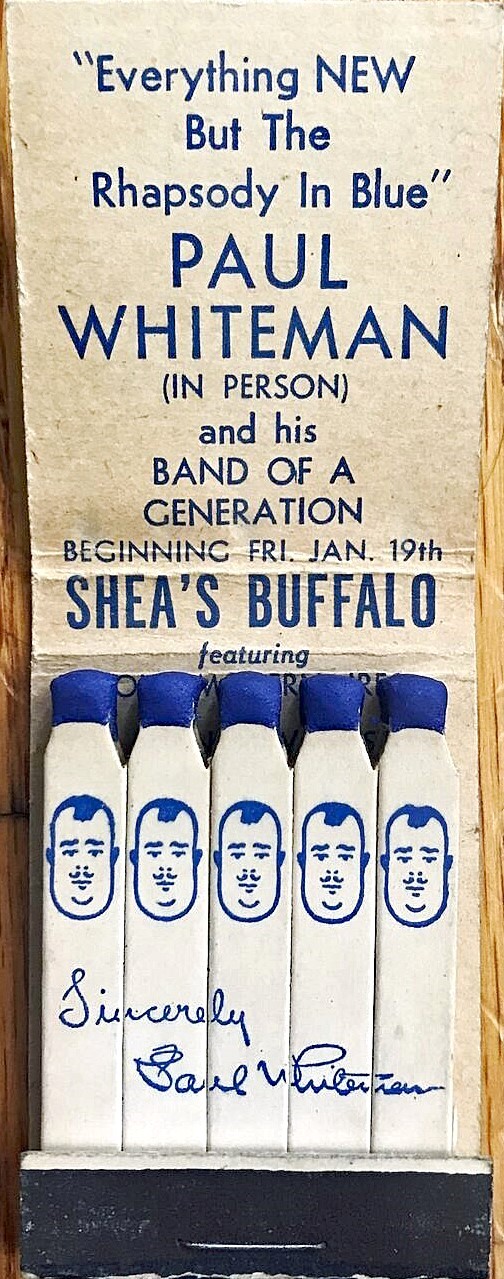
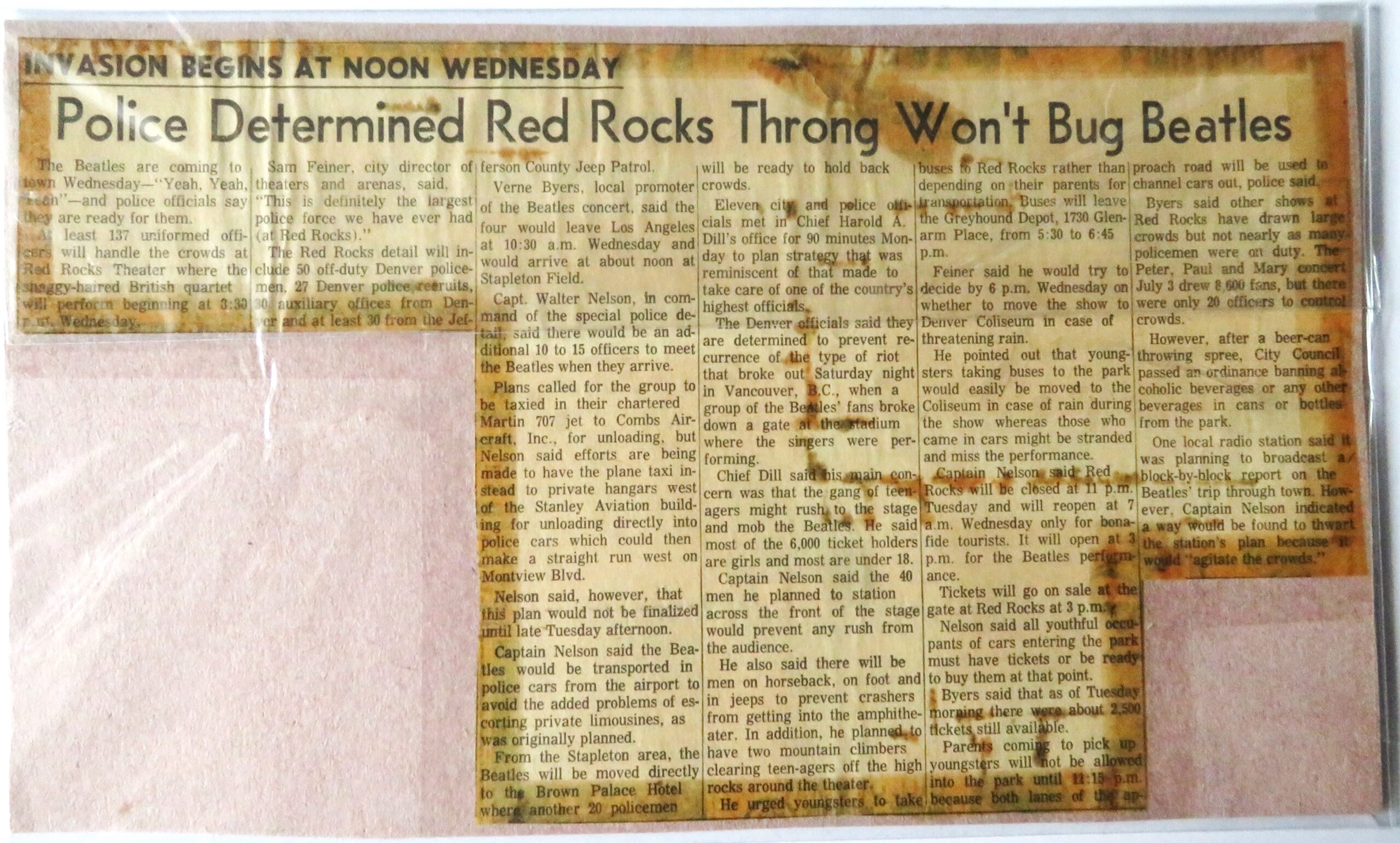
Although currently known as one of the premier concert venues in the world, Red Rocks Amphitheatre was not always the scene for “rock” concerts. Classical concerts and ballet performances at Red Rocks in the late 1940s and ‘50s were regular events. Notable performers during this time included Igor Stravinsky, Benny Goodman, Jeannette McDonald, Lily Pons and the Mormon Tabernacle Choir. In 1959, the first attempt at a rock and roll act by Ricky Nelson, was rained out and moved to the Denver Coliseum. But by the early 1960s, popular music became an increasing presence at Red Rocks, with appearances by Ray Charles, Judy Collins, Peter, Paul, and Mary, and the Smothers Brothers.
In 1964 during “Beatlemania,” Red Rocks became the sixth stop on the Beatles 32-day visit to the U.S. On August 26, 1964, the Beatles performed at Red Rocks in the venue’s first true rock concert. Tickets were $6.60 but only three-fourths of the seats sold, making this the only stop on their first American tour which did not sell out. “I remember it was very high and the air thin,” drummer Ringo Starr later recalled. “They were giving us hits from oxygen canisters.”
In our collection, The Hall has a 1964 newspaper clipping about the Beatles’ appearance at Red Rocks. The article details all of the security measures that Denver Police would be taking upon their arrival and their performance at the iconic venue.
Flash Cadillac and the Continental Kids were formed in 1969 at the University of Colorado in Boulder. The band got its name from Hughey Plumley who spent most of his time in the back of a Boulder bar, The Sink, and who entertained himself by creating names for bands. The Flash Cadillac shows at Tulagi quickly became the biggest weekly events in Boulder. According to band member Kris “Angelo” Moe, “suddenly the whole town of Boulder was mobilizing every Tuesday night for some spectacular happening.”
The group went to Los Angeles in 1970 to try to break into the music scene there, living together in a house they called “The Tiltin’ Hilton.” In 1972, the band became the first act to perform on TV’s American Bandstand without having a record release. They went on to perform as a band in movies and on TV, including as “Herby and the Heartbeats” in the 1973 George Lucas film American Graffiti and “Johnny Fish & the Fins” in the TV show Happy Days, which was written especially for them. In 1979, they also appeared in Francis Ford Coppola’s epic Vietnam film Apocalypse Now.
In the late 1970’s, the band members moved back to Colorado where they purchased a small ranch near Woodland Park, in the mountains west of Colorado Springs. In the 1980s, Flash Cadillac performed as the house band for the nationally broadcast Super Gold weekly radio program.
In The Hall’s collection, we have an original United Kingdom advertisement for the 1972 debut album of “Flash Cadillac and the Continental Kids.” The ad shows individual photos for each band member identified by their stage names and contains a quote from a Rolling Stone review stating that “Flash Cadillac and the Continental Kids are the best rock and roll stage act I’ve ever seen.”
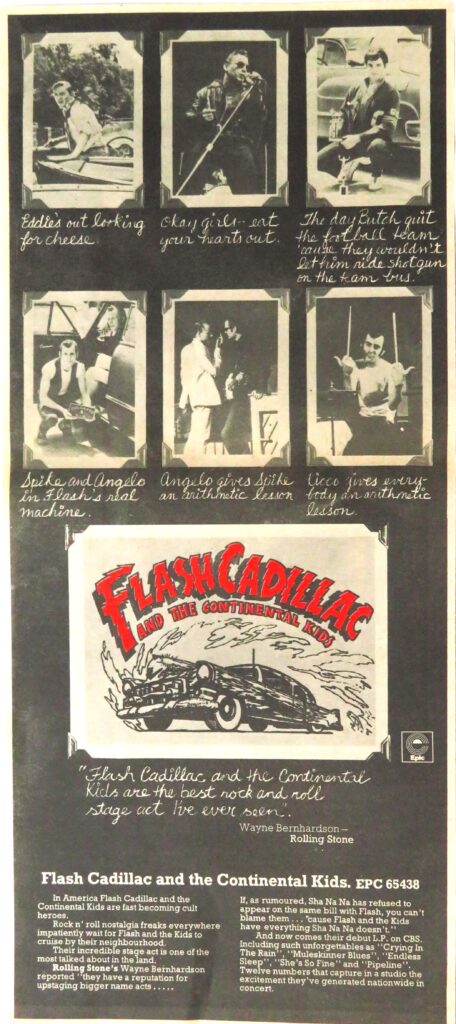
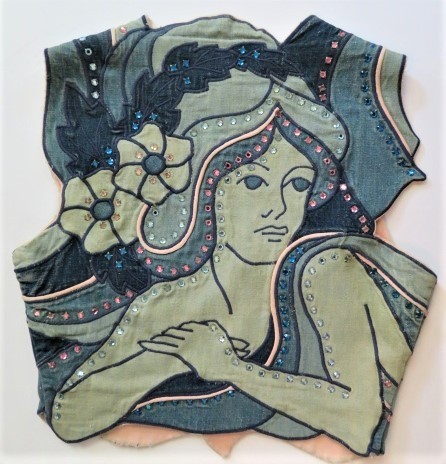
Known as a Boulder-based musical party act, the roots of Freddi & Henchi stretch back to the desert city of Phoenix, Arizona. Freddi “Love” Gowdy founded the rhythm and blues/funk band Freddi Love and the Soulsetters in 1965. Shortly thereafter, Marvin “Henchi” Graves joined the band and added his great dancing skills to the group. It was in Phoenix where group members first established their exciting stage presence through dance steps, matching costumes and live shows at local nightclubs.
They were taken under the wing of producer Hadley Murrell, establishing a fun-loving sound and an identity as the “Crown Princes of Funk.” The band played its first Colorado show at a country music bar in Fort Collins. But the band’s legendary “Freddi Henchi Party” also attracted hundreds of college students, who packed the house. The band relocated to Boulder in 1970 and got a new name along with a new home. For the next 15 years the Freddi-Henchi band headlined at venues across Colorado, west to California, and east to Chicago.
The band went through numerous personnel changes in the late ‘80s and ‘90s. Marvin “Henchi” Graves passed away in 2009 after a long battle with cancer. Freddi Gowdy continues to perform as the co-frontman and vocalist in fellow Hall of Famer’s band, Chris Daniels & The Kings. Together, Freddi & Henchi created a groove-laced, falsetto dual-lead-vocal sound that would be later heard in Earth Wind & Fire and other funk acts.
In our collection, The Hall has an original blue denim stage costume worn by Henchi during the 1970s. The pants have rhinestones in blue and pink and embroidered images of a woman on each pant leg. The vest has rhinestones and pink accents with an embroidered image of a woman’s face on the back. Both pieces are original creations of fashion designer Valerie McCreary of Boulder, Colorado.
In 1977, KBCO started broadcasting from Boulder, Colorado as a 1,000-watt FM station with a loyal following and a Class C license, which allowed an upgrade to 100,000 watts. The original vision for KBCO was to create a music station that reflected the city’s unique population. It was dubbed “Boulder Radio” and played a mix of soft, acoustic “Colorado music.” By the mid-1980s, KBCO boasted an antenna that could reach across the Front Range. Deejays selected the songs to play on their own shows from a broad music library. KBCO was the first station in Colorado to play music from CDs on equipment imported from Japan. KBCO was a founder of the Adult Album Alternative (Triple A) format, which it is still known for today.
In May of 1980, the station launched the Kinetic Sculpture Challenge, a competition of human-powered amphibious crafts made from whatever materials the builders had available. The teams raced across a 5-mile course through mud, down dirt roads and over water at the Boulder Reservoir. The event was well-publicized with crowds of over 35,000 people. The annual KBCO Boulder Kinetics race was a Colorado tradition for over 25 years.
In our collection, The Hall has an original poster advertising the 10th Anniversary of KBCO-Coors Kinetics. The schedule of events included the Kinetic Sculpture Challenge parade, the Kinetic Ball featuring the legendary 4-Nikators (members of inductee bands, Zephyr and Flash Cadillac), Kid’s Kinetics and the Kinetic Balloon Classic.
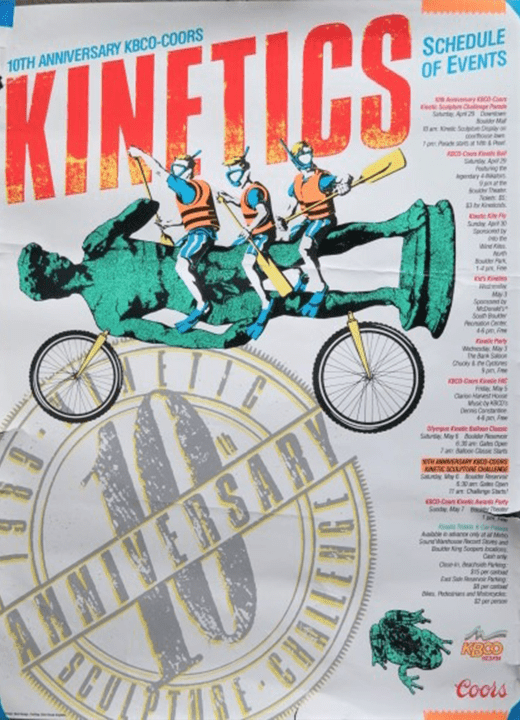

To raise the money to buy his first trombone, Alton Glen Miller milked cows in Missouri where he lived as a boy. As a teen in 1918, Miller and his family moved to Fort Morgan, Colorado, where he added the second n to “Glenn” while serving as editor of his high school yearbook. By the time he graduated from Fort Morgan High School in 1921, he had decided to become a professional musician. He even missed his own graduation due to an out of town gig, while his mother received his diploma for him.
In 1923, Miller entered the University of Colorado at Boulder. He spent most of his time away from school, attending auditions and playing any gigs he could get. After failing three out of five classes, he dropped out of CU to pursue a career in music.
Glenn Miller and His Orchestra was the best-selling recording band from 1939 to 1942. It was also a touring band that played multiple radio broadcasts nearly every day. At the peak of his civilian career in 1942, Miller decided to join the armed forces, which meant forsaking his income of about $20,000 per week (equivalent to nearly $360,000 per week in 2022). His military group, the Major Glenn Miller Army Air Forces Orchestra, was also extremely popular and successful. Miller was preparing to move his group from England to France when he went missing in action on December 15, 1944, on a flight over the English Channel.
In our collection, The Hall has an advertisement from the “400 Songs to Remember” magazine, released in December 1941. The ad is for early record home recording equipment. The complete outfit, including six two-sided blank vinyl records, was only $2.98. The ad shows a photograph of Glenn Miller, “America’s number one band leader,” as he listens with interest to the “playback” of one of his recent recordings.
Lannie Garrett arrived in Denver from Chicago at the age of 22 and began performing at a cabaret in Larimer Square. She was named Favorite Female Vocalist several years in a row by The Denver Post readers and similar recognition from readers of 5280 Magazine and the LGBTQ community’s Outfront Magazine. Garrett operated Ruby, a club on 17th Avenue, and spent a decade as the house entertainer at the Denver Buffalo Company.
In 2006, she opened Lannie’s Clocktower Cabaret, a nightclub in the historic clocktower in downtown Denver, where she hosted national acts and top local entertainment. Garrett took to the stage herself with a succession of themed shows, from fronting her “AnySwing Goes” big band as a sequined chanteuse to displaying her comedy chops in the “Patsy DeCline Show,” her campy spoof of country music.
Garrett started playing Patsy in 1991 at the Denver Buffalo Company where her performance as a washed-up country singer was an immediate hit. Patsy sings songs from her many hit albums with titles like “Take Your Tongue Outta My Mouth ‘Cause I’m Kissing You Good-bye.” Patsy and her band, the Lazy Boy Rockers, poked fun at subjects ranging from plastic surgery, love and marriage, to rehab and Elvis Presley. According to a review in the Rocky Mountain News, “if you love country music or hate country music, you will love this show.”
In The Hall’s collection, we have a pair of western boots from the stage costume worn by Lannie Garrett in her “Patsy DeCline” show. The boots go along with Patsy’s “Elvis” cape, which is currently on display in our museum at the Red Rocks Trading Post.
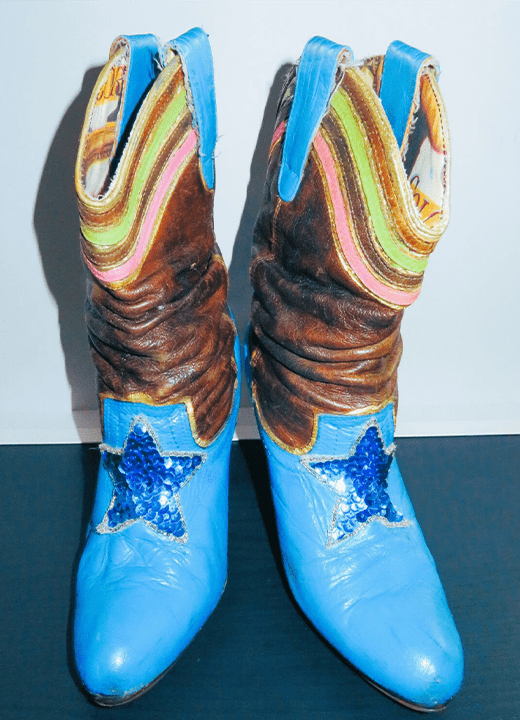
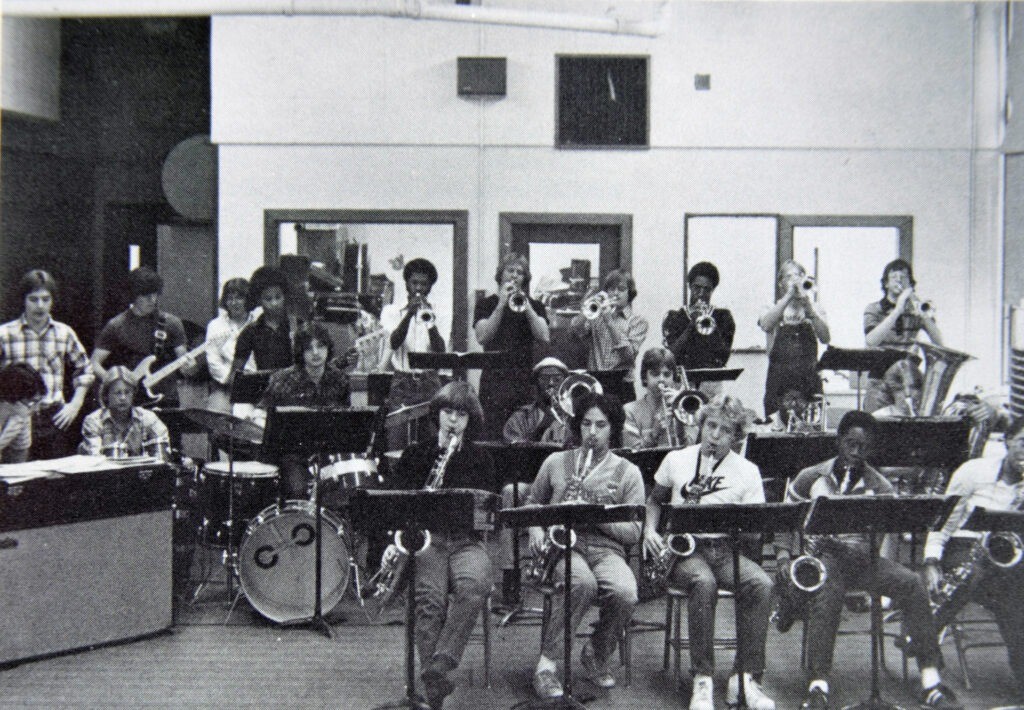
Ron Miles was born in Indianapolis, Indiana, but his family relocated to Denver when Ron was 11 years old. In Denver, he picked up his first trumpet during a summer music program. He attended Denver East High School, where he played in the Jazz Band along with actor Don Cheadle. Miles studied music at University of Colorado – Boulder and the Manhattan School of Music in New York City, where he earned a master’s degree.
Miles recorded a total of 12 solo albums and 25 albums as a sideman for other artists throughout his 35-year career. He received national recognition playing with the Duke Ellington Orchestra, Cream drummer Ginger Baker, and the Bill Frisell Quartet, among many others.
Miles balanced his musical recording career with his career as an educator. He served as the director of Denver’s Metropolitan State University innovative Jazz Studies program. His desire to mentor others was shared with students of all ages. Miles was known for giving freely of his time, never charging for lessons. On several occasions, he played alongside students from the Summitview Elementary Jazz Band at the Greeley Jazz Festival. It was a great loss to our musical culture when Miles passed away in March 2022 at the age of 58.
In our collection, The Hall has a 1981 yearbook photograph of the Denver East High School Jazz Band with Ron Miles on trumpet (third from right in back row) and Don Cheadle on saxophone (second from right in front row).
Zephyr was a hard rock band formed in 1969 in Boulder, Colorado. Original members included husband and wife David and Candy Givens, John Faris, Robbie Chamberlin, and a teen-aged lead guitarist named Tommy Bolin. Although the charismatic performances by Candy Givens were the band’s focal point, the flashy guitar work of Bolin is what the band is best remembered for.
Bolin was able to get an audition for the band with Barry Fey who liked what he heard, especially the guitar work of Bolin. Fey set up a showcase for them in Los Angeles at the legendary Whiskey a Go Go nightclub. Zephyr performed throughout 1970 and 1971, opening for such luminaries as Jimi Hendrix, Led Zeppelin, Mountain, and Fleetwood Mac.
Zephyr’s second album, Going Back to Colorado, was recorded at the prestigious Electric Ladyland Studios in New York. Tommy Bolin quit Zephyr in 1972 and formed a new band before eventually joining the James Gang and then Deep Purple. In 1973, the remaining members of Zephyr joined two members of Flash Cadillac to become the Legendary 4-Nikators.
The band’s first self-titled release, Zephyr (sometimes referred to as the “rainbow in the bathtub” album), reached No. 48 on the Billboard 200 chart in March 1970. In 2013, the original recordings were remastered, and the Zephyr album was re-issued in green vinyl as a limited edition of just 500 copies. This release was publicized as The Debut Recordings of Guitar Legend Tommy Bolin. The Colorado Music Hall of Fame has one of these albums in its collection.
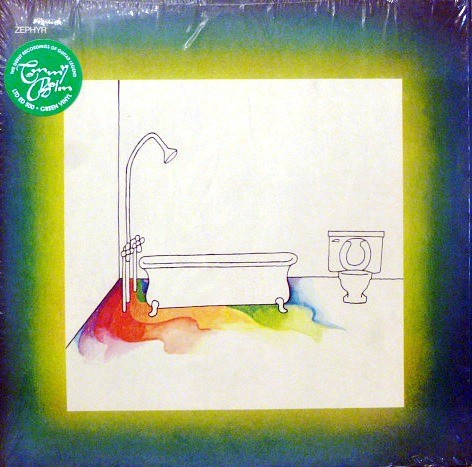

In Denver, the generation that grew up in the 1950s and 1960s had its worldview formed by KIMN Radio, located at 950 on the AM radio dial. In any town within listening range, kids and KIMN went together. The station was always there—on the small transistor radios that teenagers carried with them to school, on the car radio, and on the speakers in the teen boutique sections of department stores.
Over the years, KIMN released several compilation albums of music which was popular in Denver at the time. These albums included KIMN Classics in 1965, KIMN Classics Vol.1 in 1966, KIMN’s Summertime 2 in 1968, KIMN’s Denver in 1969, and The KIMN Gold Mine in 1970.
Colorado Music Hall of Fame has several of the KIMN Radio compilation albums in its collection including a 1985 KIMN Christmas in the Rockies album. This release included recordings of classic holiday music by four Denver area performing groups: The Colorado Children’s Chorale, The Colorado Philharmonic Orchestra, The Arvada Center Orchestra and Chorus, and the Denver University Tuba Ensemble.
The Rocky Mountain News described Walt Conley (2019 Hall of Fame inductee) as the founding father of Denver’s folk scene, which began in the late 1950s and stretched into the mid-1960s. In the summer of 1960, Conley opened his home to a young and unknown Bob Dylan and introduced Denver to The Smothers Brothers that same year.
Conley’s first professional folk singing gig was at the Windsor Hotel in Denver performing calypso songs. The hotel’s public space included three bars, and Conley was often booked in all three of them on the same night. Conley then made his way to being a regular performer at a premiere folk venue in Denver called Little Bohemia. It was there that he met a young folk musician and Denver native named Judy Collins.
As the folk music scene in Denver, and the United States, began to fade in the early 1970s, Conley moved to Hollywood to try his hand at acting. He had numerous roles in a variety of popular TV shows and feature films from that time, while making his primary living doing voice-overs for TV commercials and films.
In our collection, Colorado Music Hall of Fame has an original 1963 poster for an appearance of “The Fabulous Smothers Brothers in Concert with Walt Conley” which was held at Denver’s East High School Auditorium. Tickets for the performance were priced at $3.50 and $3.00!
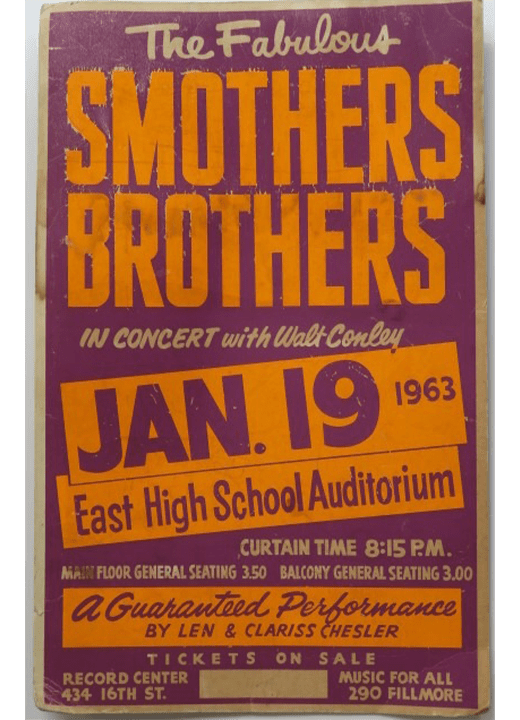
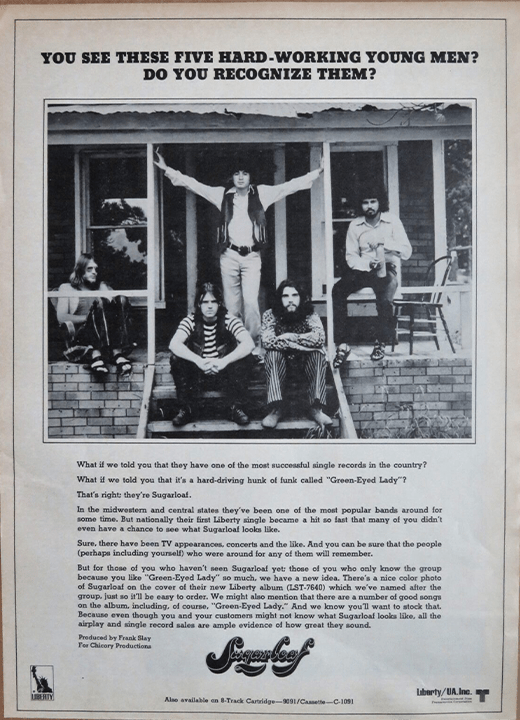
Sugarloaf was an American rock band which formed in Denver, Colorado, originally as the band Chocolate Hair. Band members Jerry Corbetta and Bob Webber played together previously in the Denver-based band The Moonrakers.
After being signed by Liberty Records in 1969, the band was told by the legal department at Liberty that the name Chocolate Hair inferred racial overtones. The band changed their name to a mountain summit in the foothills above Boulder, transforming the group into Sugarloaf. The band scored two Top 10 hits, with the singles “Green-Eyed Lady” reaching #3 in 1970 and “Don’t Call Us, We’ll Call You” peaking at #9 in 1974.
In our collection, The Hall has a 1970 full-page advertisement from Tape CARtridge magazine promoting the band and their first album Sugarloaf. The ad labels the song “Green Eyed Lady” as a “hard-driving hunk of funk”. Because the song became a hit so fast nationally, the ad was placed to introduce music retailers to the five band members. The Liberty Records ad mentions that the album is also available on 8-Track cartridges and cassette tapes.
Rocky Mountain High is the sixth studio album released by American singer-songwriter John Denver in September 1972. It was his first U.S. Top 10 album (No. 4), propelled by the single “Rocky Mountain High,” which reached No. 1 in Canada. The album’s cover photograph was taken at Slaughterhouse Falls, Rio Grande Trail in Aspen, Colorado, where Denver lived.
One of the two official state songs of Colorado, “Rocky Mountain High” is a folk-rock song written by John Denver and Mike Taylor. Denver told concert audiences in the mid-1970s that the song took him nine months to write.
The Hall of Fame has two copies of this iconic album in our collection. One can be viewed in the John Denver exhibit at the Colorado Music Hall of Fame museum at Red Rocks Trading Post. The other is in our archives and was donated to The Hall, along with a number of other John Denver memorabilia, by Julie Johnson.
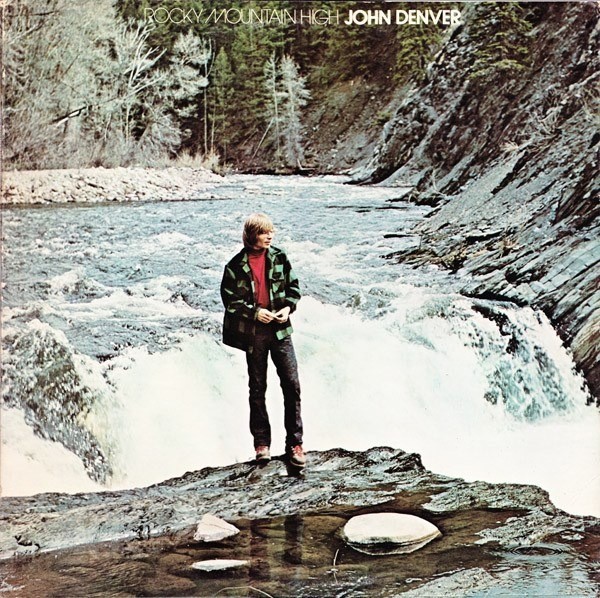
Dan Fogelberg was born in Illinois but made Colorado his adopted home state in the mid-70’s when he purchased Chris Hillman’s home in Nederland. In his song, Leader of the Band, he references his Colorado roots: “I’m in Colorado when I’m not in some hotel.” In the early ‘80’s, he bought land near Pagosa Springs, where he built his Mountain Bird Ranch and recording studio.
Annually from 1972 until 2003, with the exception of just four years during that time, Fogelberg was on tour. Over the years, his tours took him to 46 of the 50 states, as well as the District of Columbia and Canada. In his song Auld Lang Syne, he references the grueling impact of these tours: “I said the audience was heavenly, but the traveling was hell.”
In Colorado alone, he performed 33 times at venues including Ebbets Field, University of Colorado- Boulder, McNichols Sports Arena, Colorado State University, the Telluride Bluegrass Festival, Fiddler’s Green Amphitheater, the Colorado State Fair, Mile High Stadium, the Boulder Theater, the Pike’s Peak Center, the Paramount Theatre and Red Rocks Amphitheatre (where he played 14 times).
In our collection, The Hall has a Henley-style sweatshirt from his 1977 tour. The shirt is embroidered with “Dan Fogelberg On Tour” and is autographed by Fogelberg in red below the words On Tour.
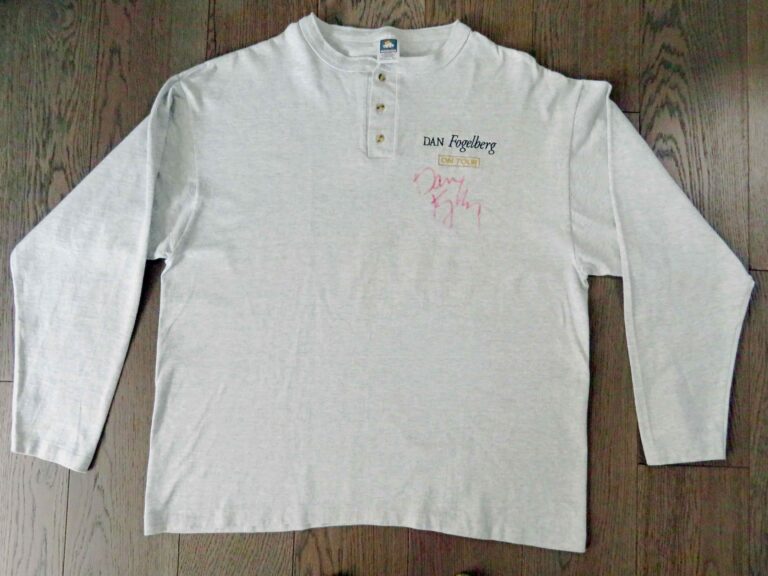
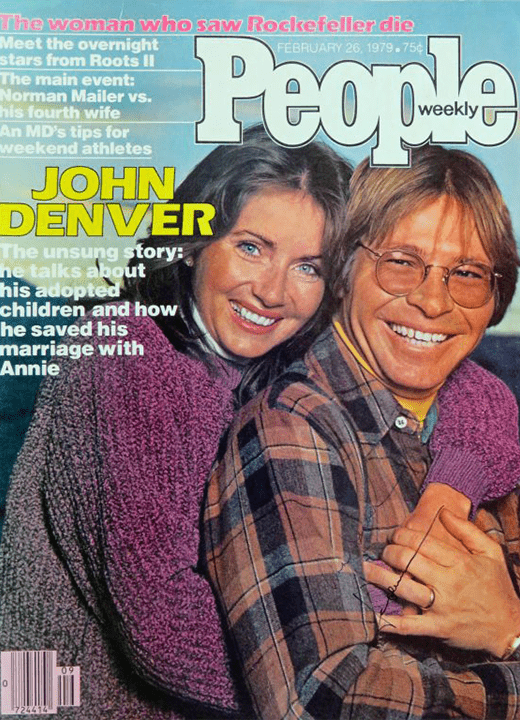
The first issue of People magazine was released in March 1974, 48 years ago. During that time, John Denver appeared in the pages of People numerous times and was pictured on the cover three times. A May 1974 article about Denver states “a segment of the rock press, unintimidated by his mass success, delights in knocking his Pollyanna perceptions.” John admits, “People ask, ‘Is he really that nice a guy?’ I can’t answer that. I got nothing to prove. I’m on no ego trip. My life is perfect. There’s not a single thing I would change.”
In our collection, The Hall has an original copy of the front page of People magazine, dated February 26, 1979. Denver, whose photograph along with his first wife, Annie, grace the cover, is the feature story in the magazine: “The Unsung Story: He talks about His Adopted Children and How He Saved his Marriage with Annie.” In the article, they both talk about their six-day separation and reconciliation in 1973, a difficult time which inspired John to write his second No.1 hit, Annie’s Song (You Fill Up My Senses).
The magazine cover has been autographed by both John and Annie Denver.
You can’t find a better time capsule for the disco era than Pop Idols and the Disco Scene, which ran in Sunday newspapers across the country from 1976 to 1980. Each week, Stan Drake (illustrator) and Brendan Boyd (writer) brought you everything from music news and pop star biographies to describing the latest disco steps.
In our collection, The Hall has a copy of the Pop Idols article from September 30, 1979. The article highlights Earth, Wind and Fire: The World’s Greatest Rock ‘N Soul Band, formed by Maurice White in 1971. According to the article, “EW&F combines long horn passages, African dance percussions, philosophical lyrics, and aggressive showmanship into a revivalist brand of party music.” The article also states, “Maurice chooses musicians for their sensitivity as well as their musical prowess.”
One third of the nine band members are former Denver East High School alumni. Philip Bailey (vocals & percussion), Larry Dunn (keyboards), and Andrew Woolfolk (flute & saxophones) were inducted into Colorado Music Hall of Fame in November 2017, along with Denver East High’s music program.

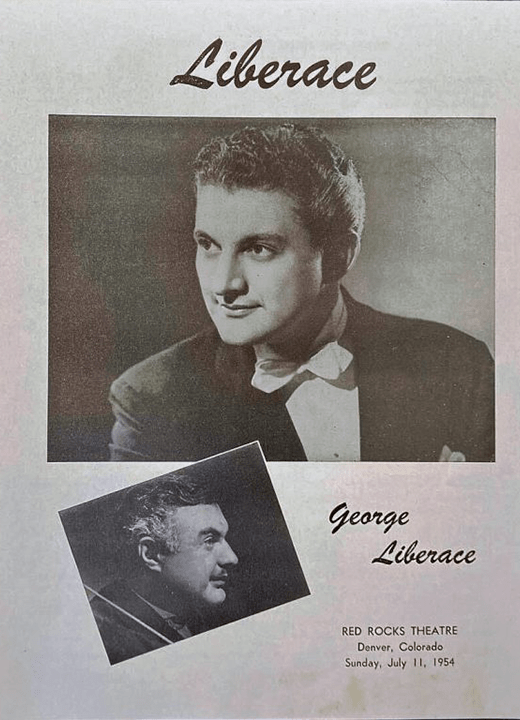
Performances at “The Garden of the Titans,” later Red Rocks Park, began in 1906. Construction of the Amphitheatre started in 1936 with formal dedication in 1941. Classical concerts at Red Rocks in the late 1940s, ’50s and ’60s were big events but sometimes a challenge for audiences. Drivers had fewer options to reach the park, and the “parking lots” were just patches of dirt. Still, the performances saw concertgoers dressed to the nines and fighting for seats.
In our collection, The Hall has a concert program from a July 1954 Red Rocks appearance by Liberace and his Columbia Recording Orchestra. His brother George Liberace, a violin accompanist and orchestral arranger, was also part of this performance. According to the program “since no two Liberace concerts are exactly alike, you are about to witness a performance that is unlikely ever to be duplicated.”
The back of the program contains an offer to receive a free full color photograph of Liberace for just 10 cents to cover the cost of postage and handling.
Colorado Music Hall of Fame inductee, The Nitty Gritty Dirt Band, was formed in 1966 in Long Beach, CA. When the San Fernando earthquake struck in 1971, the band members, most of them California natives, decided to move to more stable ground. They left Los Angeles to relocate to the Colorado mountains, settling into the wooded communities of Evergreen, Golden and Aspen.
In the Hall’s collection, we have a framed Nitty Gritty Dirt Band concert poster for their two February 1973 shows at the Cowtown Ballroom in Kansas City, MO. The opening act for these shows was comedian Steve Martin. Martin did his stand-up comedy routine opening for the band in the early 1970s. The band played on Martin’s 1978 hit song “King Tut,” credited as “The Toot Uncommons” (as in Tutankhamun).

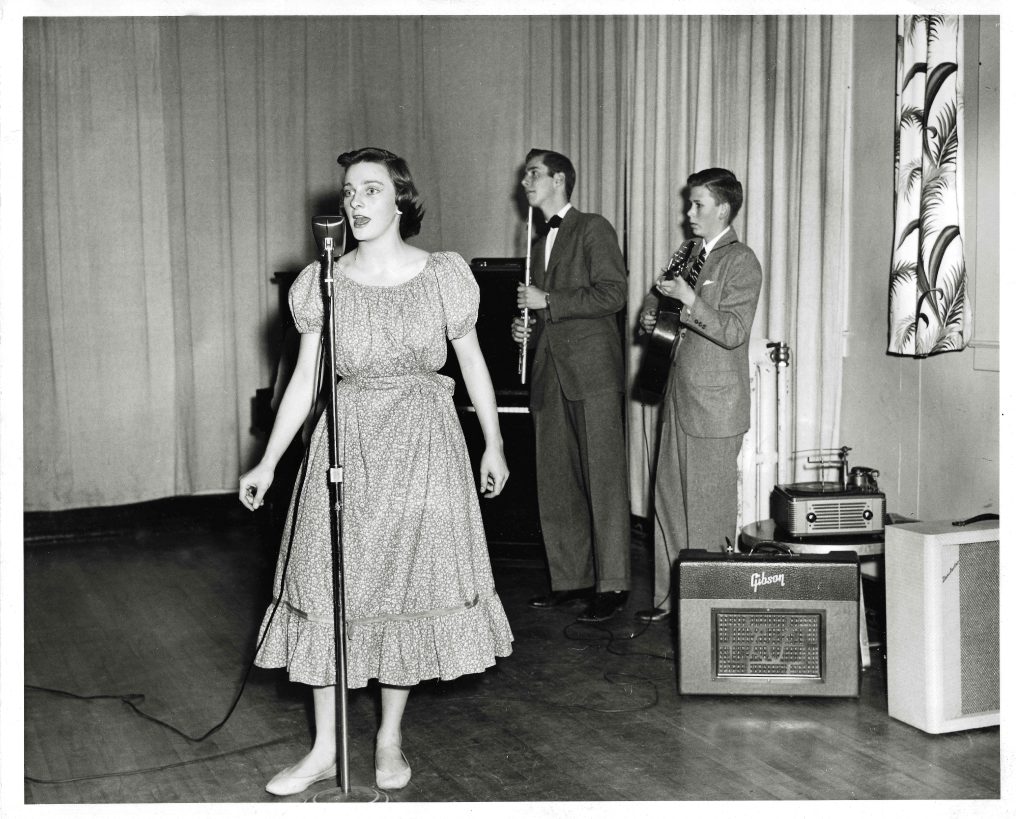
Inducted into Colorado Music Hall of Fame in 2013, Judy Collins is an American singer and songwriter with a career spanning seven decades and an iconic 55-album body of work. Collins began her impressive music career at the age of 13 as a piano prodigy, dazzling audiences with the Mozart “Concerto for Two Pianos.” But her interest in folk music and the guitar soon took her away from the piano. She discovered the Denver Folklore Center where she spent all of her babysitting money on records.
Her summer job between her sophomore and junior year at Denver’s East High School was at the Sportsland Valley Guest Ranch near Winter Park, CO. When the day’s work was done, she sang folk songs in the big main room, where the guests gathered for mulled wine after a day of horseback riding. Colorado Music Hall of Fame has in its collection a black and white photograph from 1954 of 15 year-old Judy Collins at this Ranch, accompanied by a piano, flute, and guitar trio.
From 1959 to 1961, Max Morath wrote, performed and co-produced 26 half-hour television programs for PBS titled “The Ragtime Era.” The series showcased the development of this uniquely American music genre at the turn of the century and brought him national recognition. His nightclub debut in New York in 1963 was followed by college tours, nightclub stints in Las Vegas, TV dates and regular guest appearances with Arthur Godfrey.
Morath had several theatrical reviews in New York before embarking on national tours. In our collection, the Hall has an autographed program from his 1976 one-man show “The Ragtime Years,” which provided a musical anthology of the history of ragtime. A champion of the classic sounds of Scott Joplin and other early musicians, Morath contributed to a sweeping rediscovery of this vital American music in the 1970s.


From the late 1950’s to the early 1980’s, KIMN was the dominant Top 40 music station in Denver. KIMN’s roots began in 1922 with the creation of station KFEL and continued until 1954 when the call letters became KIMN, the last three a designation for “Inter Mountain Network.
The KIMN song survey also began life in 1954 with a simple “Top 10” position. At that time there were no “boss jocks”, “KIMN Countdowns” or the issuing of weekly “Nifty Top Fifty” survey sheets. The survey contents were based on Denver area record sales, listener requests, and plays on music coin machines.
KIMN’s methodology for selecting its weekly top hits quite often led to some rather obscure music being played. Their playlist also highlighted the popular local rock n’ roll bands of that era, such as the
Astronauts, Daniels, Fogcutters, Moonrakers, Soul Survivors, and others. The station had several nicknames including the Denver Tiger, Boss Radio, and 95 Fabulous KIMN.
In 1978, KIMN changed their format to more “adult contemporary” music. By the 1980’s, FM radio was moving the AM stations from the past aside. By 1987, the once proud and ferocious KIMN Tiger had fallen to a lowly 15th position in the Arbitron Ratings with only a 2.7 audience share. The dreaded day arrived on April 26th, 1988. At precisely 12 noon, KIMN 950 AM, the Denver Tiger, went silent. In its place, KYGO AM 950 “All Country” emerged.
The image is of an original KIMN Hit Parade list for the week of May 10, 1961. The list contains the top 50 songs being played on KIMN for that week. #1 on the list was Travelin’ Man / Hello, Mary Lou by Ricky Nelson. Some other well-known artists on the list that week include Elvis Presley, Connie Francis, Roy Orbison, the Shirelles, Neil Sedaka, Brenda Lee, and Pat Boone.
Some of the lesser-known artists that week were Johnny Dankworth, Ral Donner, the Roomates, Janie Grant, the Frogmen, the Paris Sisters, and B.Bumble & The Stingers.
The back page of the survey that is mentioned on the listing promotes the “POGO POGE TEEN DANCE” held every Saturday evening at Denver’s Mammoth Gardens, now known as the Fillmore.
2013 Hall of Fame inductee Serendipity Singers was a nine-member, folk-oriented group. From its origins on the Front Range, the act moved to New York City in hopes of landing a recording contract, and signed with Philips Records. After releasing six albums, a Hot 100 single and a single that made the Adult Contemporary Charts, the Serendipity Singers appeared on television shows ranging from Hollywood a Go-Go to The Dean Martin Show, The Tonight Show and Shindig!
CMHOF has several Serendipity Singers artifacts in its collection including: An original motion-picture soundtrack album for the United Artists film The Way West, released in 1967. The group is featured on three songs on the album, including the title track and the finale. The music for The Way West was considered the last classic Western movie score written until John Barry’s music for Dances with Wolves appeared two decades later. The title track from the album was released as a single but did not chart. The group released one more LP for United Artists in 1968, Love Is a State of Mind, which was the Serendipity Singers’ final album to feature original members of the group.
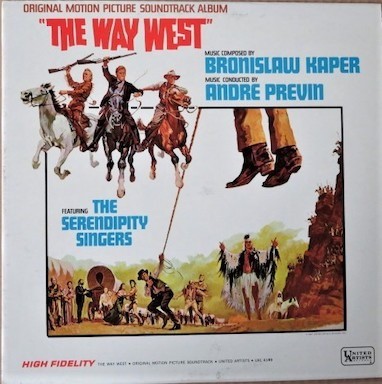
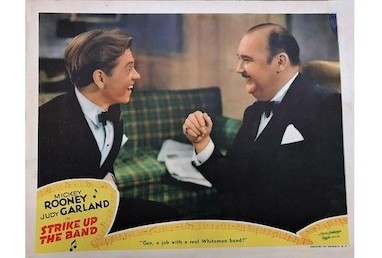
Paul Whiteman was born in Denver, Colorado, in 1890. He enlisted in the Navy during World War I, and his musical abilities resulted in the Navy putting him in charge of his own band. In 1920, he moved to New York, where his first recording sold more than two million copies, making Whiteman an instant star.
CMHOF has several Paul Whiteman artifacts in its collection, including an original Lobby Card from the MGM musical Strike Up the Band starring Mickey Rooney and Judy Garland, and featuring Paul Whiteman and His Orchestra. In the movie, Jimmy (Rooney) and girlfriend Mary (Garland) want to take part in Paul Whiteman’s high-school band contest, but they can’t afford the entry fee. By chance they meet Whiteman in person, who ends up lending them the money.
The Colorado Music Hall of Fame artifact collection includes a Lobby Card and Japanese 45 RPM record from The Astronauts, 2012 Hall of Fame inductee. The Lobby Card featured is from Great Britain and depicts The Astronauts in the 1964 movie Surf Party. It was created by a film studio and intended for display outside movie theaters in a special glass display box.
In 1964, The Astronaut’s record company discovered that the act had a growing fan base in Japan. A Japanese 45 RPM record was released in April 1964 with the songs “Movin’” (retitled “Over the Sun” and “Baby Let’s Play House.” It hit #1 in Japan, where the band enjoyed its greatest success, outselling the rival Beach Boys.
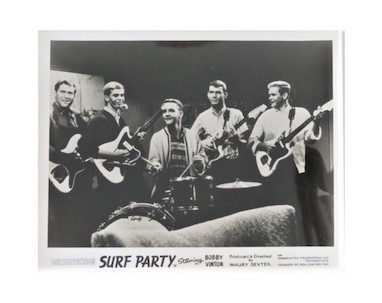

After she signed an exclusive contract with inventor and businessman Thomas Edison’s company, Spencer’s “dramatic soprano” was heard on numerous studio recordings, participating in solos, duets, trios, quartets and choruses. Having made only phonograph cylinders, Edison decided to add a disc format to his product line in order to compete with such rivals as the thriving Victor Talking Machine Company. The majority of Spencer’s best work was on the Diamond Disc, which reproduced the quality of her singing with greater accuracy.
We have several Elizabeth Spencer artifacts in our collection, including a 1914 Diamond Disc recording of “Somewhere A Voice Is Calling” by Spencer and Vernon Archibald. The other side of the disc contains the song “A Perfect Day” by the Metropolitan Quartet. Diamond Discs were expensive––the record sleeve shows a price of $1.50, which is equivalent to about $39 today.
In addition to the Diamond Disc, we have an original postcard from the early 1910s advertising Spencer’s appearances at Churchill’s, which at the time was New York City’s elite restaurant located in Times Square. The three-story terracotta brick building could seat up to 1,200 diners and employed a staff of over 300. The musical entertainment was often provided by Maurice Levi and his Orchestra, with Spencer on vocals.
Recording artists came to the Caribou Ranch near Nederland not only for seclusion and scenery, but also for the unique sound that could be produced there. Sound engineer and physicist Tommy Dowd attributed this sound to the thin air at the Ranch’s altitude of 8,600 feet.
That altitude would have a negative effect on some artists, though, so Jim Guercio, Caribou Ranch owner, equipped the studio with an oxygen tank, the one featured in our collection. In July 1974, Elton John invited John Lennon to visit the Ranch for four days, as part of his eighteen-month “lost weekend” with May Pang. In a 2008 Rocky Mountain News article about the Ranch, May Pang shared this memory about the altitude:
“I was not prepared. I don’t think John was prepared. In the recording studio, I said, ‘John, what’s this?’ He said, ‘That’s an oxygen tank.’ I didn’t understand that the air was so crisp and thin that you might need it.”
According to Guercio, while the two were recording, John Lennon would desperately grab for the oxygen tank tube after each take.

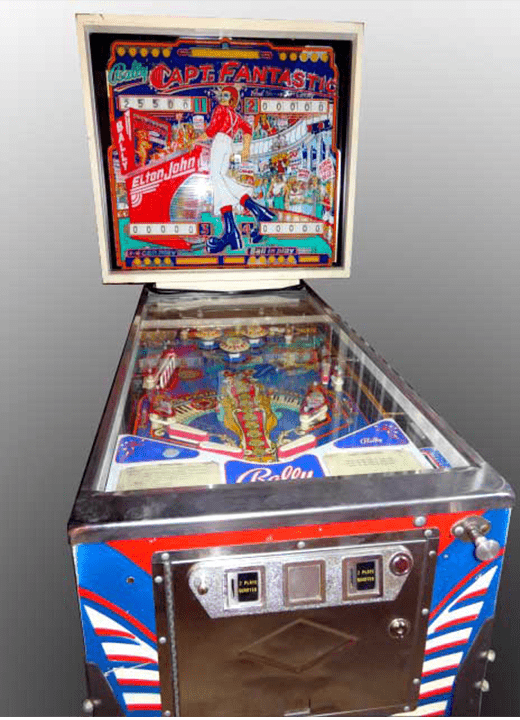
This pinball machine was inspired by the 1975 movie Tommy, and includes a representation of Elton John, as his character in the movie, playing pinball. The name Captain Fantastic came from the title of Elton John’s 1975 autobiographical song and album, Captain Fantastic and the Brown Dirt Cowboy. The lyric “From the end of the world to your town” appears at the very top center of the backglass.
Barry Fey, one of rock music’s most prolific and successful promoters, wrote about how he and Bruce Springsteen played pinball on this machine in his 2011 book, Backstage Past:
“At last, they get to the party and everybody’s having a good time. Bruce and I are playing pinball and one of his sycophants is rooting him on, ‘Get him Boss! Get him Boss!’ I looked at him and said, ‘I beg your pardon. This is my house. I’m the f***in’ boss.’ I cleaned Springsteen’s clock, but it wasn’t really fair. I had home-field advantage because I played a lot on that machine; a ‘Captain Fantastic’ version given to me by Elton John.”
2024 Colorado Music Hall of Fame | 2024 Colorado Music Hall of Fame